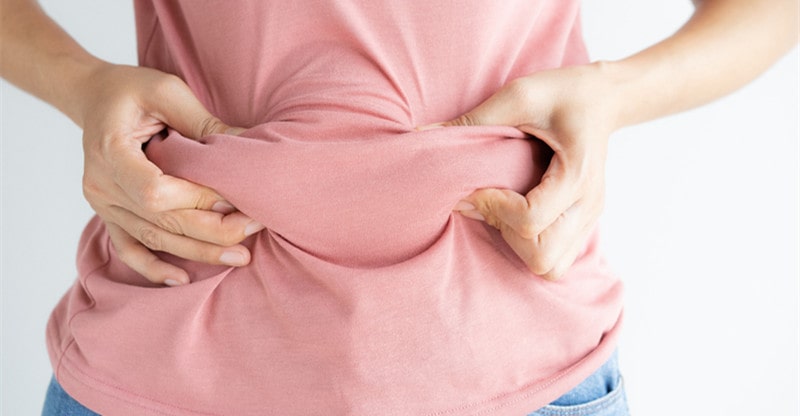14 Simple Ways to Foods to eliminate belly fat on Science
Belly fat is one of the most accessible and difficult to get rid of fats in the body. It is also the most inconvenient as everyone can see and can’t enjoy wearing anything you like as you need to remember to buy roomy clothes that don’t tighten in the abdomen. This is why losing belly fat or tummy fat is a common weight loss goal.
As well as affecting your appearance, belly fat can also affect your health. Therefore, steps should be taken to reduce this fat accumulation as promptly as possible. For this reason, losing this fat can be of great benefit to your health and well-being.
Generally speaking, there are two types of fat that accumulate in the abdomen, one is excess visceral fat that can interfere with the function of your internal organs and the other is subcutaneous fat that can sway forward as you move. It is worth noting that losing weight from a specific area of the body (especially the abdominal area) can be tricky, but it is not impossible.
With a combination of diet and lifestyle changes and some exercise, you can achieve a flat tummy and a slim waist. This article will provide you with guidance on what foods to eat to lose belly fat.
Here are 14 evidence-based ways to lose belly fat.
Foods that help reduce belly fat
1.Protein
Protein is probably the most important macronutrient for weight loss.
Protein-rich foods such as Greek yoghurt, almonds, pecans, soybeans, sunflower seeds, skinless chicken breasts, lean meats, eggs, fish, and vegetable protein powders can help reduce belly fat. These are the best sources of protein for your diet. They also make you feel full for a long time so you don’t crave food as often.
Studies have shown that it can reduce cravings by 60%, increase your metabolism by 80-100 calories a day and help you reduce your daily intake by up to 441 calories!
If weight loss is your goal, then adding protein may be the most effective change you can make to your diet.
Not only will protein help you lose weight, but it will also help you avoid weight regain.
Protein may be particularly effective in reducing belly fat. One study showed that people who consumed more and better protein had much less belly fat.
Another study showed that protein was associated with a significantly lower chance of abdominal fat gain in women over a 5-year period.
This study also linked refined carbohydrates and oils to more abdominal fat and linked fruit and vegetables to reduced fat.
Many studies that have observed that protein helps with weight loss have shown that people get 25-30% of their calories from protein. Therefore, this may be a good range to try.
If you are struggling to get enough protein in your diet, a good quality protein supplement such as whey protein is a healthy and convenient way to increase your total intake. You can find many protein powder options online.
2.Vegetables and fruit
Green leafy vegetables can help prevent your body from storing fat. And red fruits like apples are great for losing weight around the abdomen and making your waistline slimmer.
3.Probiotics
Foods that are good for your gut, such as yoghurt with Lactobacillus strains and probiotic supplements, help speed up your metabolism and thus prevent fat from building up in your body.
4.Apple cider vinegar
Consuming diluted apple cider vinegar, especially first thing in the morning, helps to reduce body fat.
5.Green tea
Green tea helps to remove visceral fat by containing a compound called epigallocatechin gallate (EGCG) which has been shown to actively promote weight loss around the abdomen.
6.Choline
Choline, which is commonly found in eggs, can help switch off the genes that cause visceral fat accumulation. This is therefore another reason to indulge in eggs.
7.Fibre-rich foods
Foods containing fiber such as oats, psyllium husks, pulses, fruits, and chia seeds can also prevent the build-up of fat in the body.
8.Spices
Ginger and cinnamon can promote weight loss by reducing swelling and slowing fat accumulation.
9.Resveratrol
It is found in large quantities in dark chocolate, fruit, and peanut butter. It can also help prevent the accumulation of fat in the body.
10.healthy fats
Eating healthy fats such as fish and olive oil, which are rich in omega-3 fatty acids, is another good way to reduce belly fat.
Stay away from processed meats, refined carbohydrates, fats, and salty foods so that you can easily lose belly fat.
11.Avoid sugar and sugary drinks
Foods with added sugar are bad for your health. Eating a lot of these types of foods can lead to weight gain.
Studies have shown that added sugar has a uniquely harmful effect on metabolic health.
Many studies have shown that too much sugar, mainly due to high levels of fructose, can lead to fat accumulation around the abdomen and liver.
Sugar is half glucose and half fructose. When you eat large amounts of added sugar, the liver is forced to convert it into fat due to the excess fructose.
Some people believe this is the main process by which sugar has harmful health effects. It increases belly fat and liver fat, which can lead to insulin resistance and various metabolic problems.
Liquid sugar is even worse in this respect. The brain doesn’t seem to register liquid calories as well as solid calories, so when you drink sugary drinks, you end up consuming more total calories.
One study observed that for every additional sugary drink consumed per day, children were 60% more likely to develop obesity ( 10 ).
Try to reduce the amount of sugar in your diet and consider eliminating sugary drinks altogether. This includes sugary drinks, sugary soft drinks, fruit juices, and various high-sugar sports drinks.
Ensure that products are free from refined sugar. Even foods marketed as healthy foods may contain high levels of sugar.
Remember that none of this applies to whole fruits, which are very healthy and contain plenty of fiber to mitigate the negative effects of fructose. We advocate eating fruit regularly.
12.Eat fewer carbohydrates
Eating fewer carbohydrates is a very effective way to lose weight.
This is supported by many studies. When people reduce carbohydrates, their appetite decreases, and they lose weight.
Over 20 randomized controlled studies now show that low-carb diets sometimes lead to 2-3 times more weight loss than low-fat diets.
This is true even when people in the low-carb group are allowed to eat as much as they want and those in the low-fat group restrict calories.
Low-carb diets also lead to rapid water weight loss, which allows people to achieve results quickly. People usually see a difference on the scale within 1-2 days.
Studies comparing low-carb and low-fat diets have shown that low-carb diets reduce fat particularly in the abdomen and around the organs and liver.
This means that some of the fat lost on a low-carb diet is harmful abdominal fat.
Simply avoiding refined carbohydrates – such as sugar, sweets, and white bread – is enough, especially if you keep your protein intake high.
If the goal is to lose weight quickly, some people will reduce their carbohydrate intake to 50 grams a day. This will put your body into a state of ketosis, in which your body starts to burn fat as its main fuel and your appetite is reduced.
In addition to weight loss, low-carb diets have many other health benefits. For example, they can significantly improve the health of people with type 2 diabetes.
13.Eat fiber-rich foods
Dietary fiber is mainly indigestible plant matter.
Eating more fiber can help you lose weight. However, the type of fiber is important.
It seems that most soluble and sticky fibers can affect your weight. These fibers can bind water and form a thick gel that ‘sits’ in your intestines.
This gel can significantly slow down the movement of food through the digestive system. It can also slow down the digestion and absorption of nutrients. The end result is a prolonged feeling of satiety and a reduced appetite.
A retrospective study found that an additional 14 grams of fiber per day were associated with a 10% reduction in calorie intake and a weight loss of approximately 4.5 pounds (2 kg) over a 4-month period.
A 5-year study reported that eating 10 grams of soluble fiber per day was associated with a 3.7% reduction in intra-abdominal fat mass.
This means that soluble fiber may be particularly effective in reducing harmful abdominal fat.
The best way to get more fiber is to eat more plant-based foods, including vegetables and fruit. Pulses are also a good source, as are some grains such as whole oats.
You can also try taking a fiber supplement such as glucomannan. This is one of the most vicious dietary fibers and studies have shown it can help with weight loss. It is important to talk to your healthcare provider before introducing this or any supplement into your diet regime.
14.Exercise regularly
Exercise is one of the best things you can do to increase your chances of living a long, healthy life and avoiding disease.
Helping to reduce belly fat is one of the amazing health benefits of exercise.
This doesn’t mean doing abdominal exercises because localized fat loss – losing fat in one area – is not possible. In one study, training only the abdominal muscles for 6 weeks had no measurable effect on waist circumference or the amount of fat in the abdominal cavity.
Weight training and cardiovascular exercise will reduce fat throughout the body.
Aerobic exercise – such as walking, running, and swimming – can significantly reduce abdominal fat.
Another study found that exercise completely prevented people from regaining abdominal fat after weight loss, which means that exercise is particularly important during weight maintenance.
Exercise can also reduce inflammation, lower blood sugar levels and improve other metabolic problems associated with excess belly fat.
Concluding remarks
Belly fat or abdominal fat is associated with an increased risk of certain diseases.
Most people can reduce belly fat by making lifestyle changes such as eating a healthy diet rich in lean protein, vegetable fruit, and pulses, and exercising regularly.
This is the real and effective guide to health











This is a very effective method Thank you